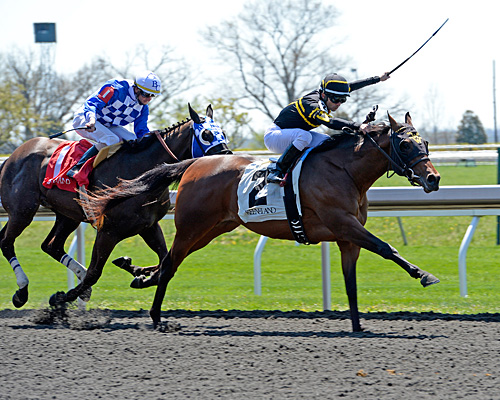By Tom LaMarra
Last year Keeneland filled seven 2-year-old races during its spring meet. Through April 23 there were two, with two more to come before the meet ends April 25.
The 2-year-old races during the 2013 spring meet averaged 9.71 horses per race. The two races run through April 23 averaged 7 horses per race, according to The Jockey Club Information Systems.

Hootenanny, a Quality Road 2yo gelding trained by Wesley Ward, won at Keeneland on April 17 - Anne M. Eberhardt Photo
So what's the deal? Blame it on the weather.
"The winter was brutal here for these guys with 2-year-olds," Keeneland vice president of racing Rogers Beasley said. "I look at it as a one-year aberration. I love the 2-year-olds; they're a rite of spring at Keeneland. But we anticipated (fewer entries because of the weather). We carded them hoping to fill them."
Trainer John Hancock, who is based at the Riverside Downs training center in western Kentucky not far from Ellis Park, agreed the weather–ice,snow, and below-freezing temperatures–was an issue in preparing 2-year-olds for some conditioners, but he still is surprised only four races filled at Keeneland.
"Everyone says it's the Polytrack, but we've had (full fields) of 2-year-olds here for years," Hancock said.
Hancock, Mark Casse, and Wesley Ward have been the most visible in those races, which has been the case for years.
Hancock said clients Blue Checker Thoroughbreds (Dave Purcell), Rick and Charles Brown, and 86-year-old William Dorminy have supported his operation with 2-year-olds.
"We bought more yearlings to get ready for this meet (and the Ellis Park meet in the summer)," Hancock said. "We've been lucky getting 2-year-olds ready to run and selling them."
Hancock said a few years ago Ward at Keeneland asked him about the slow workouts at Riverside Downs and whether they really were that slow. Riverside Downs, a former harness and Quarter Horse facility, has a half-mile track maintained by the horsemen that stable there.
"It's a very deep surface but it's a great place to get a horse ready to run," Hancock said. "You can run an elephant out of there."
Hancock closes the spring meet with 2-year-old filly Smokin Red, owned by the Browns, entered April 24, and two colts–Indygo By You and Storm Off, both owned by Blue Checker–entered for closing day.
* * * * *
With the transition from Polytrack back to dirt to begin at Keeneland this spring, all horses in Barns 1-49 must be off the grounds by May 15. Training on the new dirt surface is expected to begin Sept. 1, about one month before the fall meet.
Beasley said some horses will remain at the Rice Road training center behind Keeneland and have access to the five-eighths-mile synthetic training track. Those who remain will have their stall rent cut in half.
"We're being very fair about that," Beasley said.
Other trainers have applied for stalls at Churchill Downs and the Keeneland-owned The Thoroughbred Center training facility in Lexington.
Beasley said the plan is to use September to tweak and test the new surface.
* * * * *
Any talk that Keeneland has had trouble attracting top horses and trainers because of its Polytrack surface doesn't add up after a glance at the current meet standings. Through April 19 the top 10 trainers, in order of wins, are Casse, Ken McPeek, Ward, Graham Motion, Christophe Clement, Tom Amoss, Shug McGaughey, Chad Brown, Mike Maker, and Bill Mott.
As for field size, it averaged 8.86 horses per race through April 19; for the entire 2013 spring meet the average was 9.35, according to TJCIS statistics. Purses thus far have averaged $597,475, up from $578,264 for the 2013 spring meet.
For the first spring meet with Polytrack–2007–average daily total pari-mutuel handle was a record $10.55 million, according to Keeneland stats. It dropped to a low of $7.42 million in 2010, but was back up to $9.11 million in 2012 and grew to $9.91 million in 2013.




